When it comes to getting seeds in the ground efficiently, no tool compares to a seeder. This low-tech gadget comes in a variety of sizes and designs, ensuring that there’s an option available for growers at almost every scale. Here are our top picks.
Table of Contents
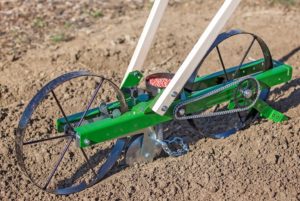
Our top pick for a garden seeder
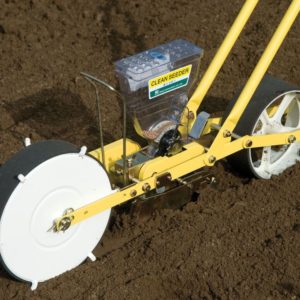
Third pick
Why use a seeder?
Most of the garden seeders discussed here are classified as walk-behind planters. They typically have a wheel in front that drives a hollow, wedge-shaped structure forward that opens up a furrow in the soil.
A closing device then drops seeds at a pre-set spacing into the ditch, and then a final wheel in the back pulls the soil back over the seed to cover it. In this way, you can plant entire garden beds merely by pushing the seeder through them.
While it’s possible to achieve the same results through hand planting, there are plenty of reasons to consider investing in a garden seeder.
Keeps you upright
Those who grow a large garden or maintain a small farm know the back pain that comes with the industry. Any tool that keeps you upright is worth investing in, as it can exponentially increase your endurance for outdoor work. Seeders prevent you from bending over while planting, which will make a significant difference in your stamina.
More even spacing
Tiny seeds are difficult to space, and hand planting often doubles your work because you need to go back through the beds later to thin out the excess. Using a garden seeder allows for more even spacing so that you both waste less seed and save yourself time in the long run.
Easily adjustable
Most seeders come with a variety of seed plates designed to fit different sized seeds with varying spacing requirements. This means that you can often use the same seeder for everything from carrot seeds to corn without you having to purchase or master multiple pieces of equipment.
Saves time
Try shuffling through the soil on your hands and knees, painstakingly placing a single beet seed every three inches. Now complete the same task with a garden seeder, and you’ll realize that it takes a fraction of the time.
True, it can take a while to change out seed plates and get your seeder ready to go, but once the device is set up, you can seed long rows with ease. Some seeders even include options for planting multiple rows at once to speed up production further.
How to choose the best garden seeder for your needs: 5 key questions
Knowing which garden seeder to invest in can be a challenge unless you have a clear idea of what you are looking for. Ask yourself the following questions to get a better sense of your goals and needs.
1. What’s your price point?
Small scale seeders vary in price between about $150 to over $500 for high-end models. While you’ll undoubtedly get what you pay for with the premium seeders, they are likely overkill for many growers. In contrast, serious market farmers are well-served to purchase a pricy model that lets them get their planting done faster.
2. What’s the scale of your location?
You need to factor in your operation’s size when choosing the right seeder. Commercial growers (those with 10+ acres in production) should consider different models than the home grower or small-scale market farmer.
Likewise, consider the size of the seed container (called the hopper). Some are so small and will require constant refilling for larger growers, while other seeders only work when the hopper is near full, which poses a problem for smaller growers that only want to plant a row or two of a variety before switching out the seed type.
3. What’s the condition of your growing space?
While most seeders will work best in loose, well-tilled soil, some models are rugged enough to handle more adverse conditions. This is something to consider if your property contains a lot of rocks or if you’re looking for an easily maneuverable unit for planting within a high tunnel.
4. How many varieties will you seed?
Consider how often you plan to switch out seed varieties in your seeder, and how much their size and spacing needs differ from each other. Some models are a pain to switch out, meaning that small-scale growers would save time hand planting instead. Others require you to purchase additional seed plates as expensive add-ons, which increases the overall price of the device.
5. How much tinkering are you willing to do?
Low-cost seeders tend to require more time and energy from the farmer. They might take longer to switch out the seed plates, or you might have to do more “damage control” by planting over areas it missed or thinning out the beds where too many seeds were dumped at once. Plan on having to spend less time tinkering when you purchase a pricier model.
The best seeders for an organic farm: our top picks
An abundance of choice leads to problems, though—how can you know which seeder is best for your needs? Let’s dive into our top picks.

Hoss Garden Seeder (Overall Winner)
Highlights: The Hoss Garden Seeder offers simplicity for seeding with high-quality construction and rugged functionality.
Price: $299
The Hoss Garden Seeder is a USA-made planting device that makes no apologies for its ultra-durable construction. It’s crafted with Amish-crafted hardwood handles that are constructed without power tools and left untreated (no potentially toxic preservatives). The seeder also contains steel wheels, a powder-coated steel frame, and a heavy-duty drag chain that covers your planted seeds immediately.
The Hoss seeder relies on seed plates that lay flat in the seed hopper, which ensures accurate spacing and minimal waste, and the rugged wheel design makes this seeder capable of traversing most terrains. If your soil is less than smooth, that’s a significant advantage.
Your purchase comes with six seed plates that are capable of covering most varieties from tiny mustard seeds to squash and pumpkins. At least seven more plates are available to expand your options.
Some might not love the Hoss Seeder’s hopper design, as it consists of a small open container. Not only will it require frequent refilling, but tip the seeder, and your seeds will spill. However, this does mean that switching out seed varieties is a simple process.
Another advantage of the Hoss Seeder is its basic construction. If you consider yourself handy, there’s a good chance that you’ll be able to fix it yourself if something goes wrong.
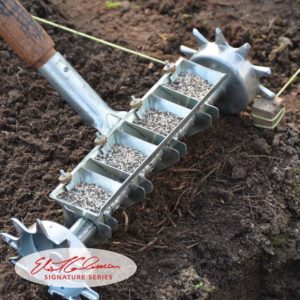
Four-Row Pinpoint Seeder
Highlights: This ultra-simple seeder is perfect for planting in tight spaces, but don’t expect to get far using it for field crops.
Price: $259
Exclusively offered by Johnny’s Selected Seeds, this Four-Row Pinpoint Seeder is designed for dense plantings, specifically in raised beds or a greenhouse setup. Esteemed organic gardener Eliot Coleman influenced the design, and it boasts a simple construction that requires minimal configuration.
The Four-Row Seeder’s minimalist design makes it easy to maneuver in tight spaces, and the steel hoppers are simple to fill and empty, meaning that you can switch between varieties in minutes. This seeder is put to best use when planting salads and brassica mixes, though some find success using it for slightly larger greens like spinach.
However, simple construction also leads to limitations. You can’t adjust this seeder’s spacing beyond the pre-set one inch, and the small hoppers drop seeds most evenly when they are almost full. This means you might need to take frequent refill breaks, even when seeding small areas. Likewise, it requires ultra-fine soil to seed adequately and will quickly get jammed on weeds and rocks.
From a construction standpoint, the entire seeder is made from high-quality steel and a hardwood handle. Minimal moving parts also mean it’s less likely to break down.

Jang JP Seeder Series
Highlights: The Jang Seeder is the first choice for many organic farmers, thanks to its planting versatility. However, some might find it touchy and difficult to set up.
Price: $440+ (depending on accessories)
Considered by many to be the gold standard of organic farm seeders, the Jang JP Seeder series is best suited for small to medium-sized seeds, though it can be modified to handle any size. Jang also sells a range of accessories that make it possible to scale up your operation. These include a tractor-mounted seeder and a multi-row seeder.
What sets the Jang apart is its reliability and versatility. So long as you pair the correct size roller for the seed you’re sowing, you can expect high accuracy, better germination rates, and a low chance that your plants will require thinning.
You can set the Jang for spacing between 0.5” and 20”, depending on the interchangeable gear, and it’s also possible to adjust the planting depth for extra control for every variety. However, it can be a pain to switch out the adjustable seeding plates, which makes this seeder most efficient when you’re planting a lot of the same variety at once.
Many appreciate the Jang’s transparent hopper, which lets you see precisely when you need to reload the seeds. This seeder’s rugged design also makes it more suitable than other options for rocky or uneven soil, though the machine itself might be too heavy for some users to handle.
Most of the Jang’s construction is high-quality steel. Even the adjustable sprockets are made from an anti-abrasive plastic, as opposed to thinner plastic like the EarthWay. The part of the seeder most likely to break is the clear plastic hopper, but this is a low impact part that shouldn’t break down with regular use. In other words—buy this seeder once, and it should last a lifetime.
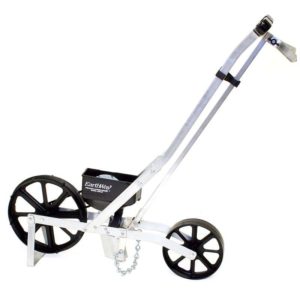
EarthWay Precision Seeders
Highlights: Though an excellent entry-level seeder for beginners and hobby farmers, EarthWay products contain a lot of plastic and likely won’t last as long as other seeders.
Price: $131.57
The EarthWay Precision Garden Seeder is considered one of the most cost-effective options for gardeners and small-scale market farmers. This basic model comes with a set of six seed plates—corn, peas, beans, carrots, beets, and radishes—but can be used for approximately 20 seed types in total. Other seed plates are available for varieties like kale, cabbage, cucumbers, and more, and you can also purchase blank seed plates to make customized spacing.
Another advantage is that EarthWay sells an optional side-dress fertilizer attachment. This means you can use one tool for two purposes, which helps you you save some of the planet’s resources by not owning more than necessary.
Despite this versatility, you might find the EarthWay’s performance to be less precise than promised. Common customer complaints indicate that this seeder gets jammed easily, or, in contrast, tends to drop clusters of seeds at once. This means you might have to go over the rows again to thin seedlings out. The problem seems worst for the smallest seed types, as it typically can handle beans, corn, and beets without issue.
However, the EarthWay’s low price makes it lose points from an environmental perspective due to lower-quality materials. While the seeder has an aluminum frame, the hopper, seed plates, and wheels are all made of relatively flimsy plastic. This means you’re likely to only get a few years of use out of it before something breaks, and these plastic components may be a challenge to recycle.
The EarthWay Precision seeder is an excellent option for hobbyists and other growers who aren’t as fussed about perfect spacing. Those who need to maximize every growing space should look elsewhere.
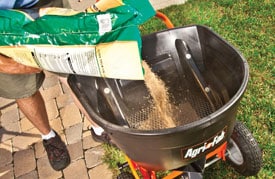
Agri-Fab 130lb Tow-Behind Spreader
Highlights: The Agri-Fab and other tow-behind seeders make quick work of planting and fertilizing, but most are paired with gas-guzzling lawnmowers that are significant sources of pollution.
Price: $179
For those looking to scale up their operation with less concern about precision, tow-behind seeders will save you time and energy for large-scale plantings. They are designed to connect to four-wheelers, riding mowers, or even small tractors, and will disperse seeds over several acres if desired. This makes it best suited for seeding pasture space, cover crops, or enormous rows of lettuce.
This Agric-Fab Tow-Behind Spreader stands apart from other brands with its rustproof hopper and US-construction (though the wheel components are made in China). It’s compatible with most lawn tractors and other small vehicles with a hitch and should last many years without problems.
This tow-behind seeder’s environmental impact will largely depend on what you’re using it transport it. Gas mowers are a major source of pollution, as the EPA estimates that they produce 11 times the amount of pollution as driving a new car for the same amount of time, and they account for up to 5% of all US air pollution.
You can make a choice for sustainability instead by pairing it with an electric riding mower, or even an electric golf cart with a hitch attachment.
Learn more about choosing an electric lawn mower here.
In summary: choosing the best garden seeder means assessing your needs
While most garden seeders have their advantages, choosing the right one for your needs comes down to knowing your priorities and investing in quality. Look for models scaled to your space, and consider whether you prefer to have a lot of options for adjustments, or whether you want a seeder you can start using immediately with minimal fussing.
No matter what model you choose, we recommend prioritizing quality construction. You want your seeder to last for seasons to come. This is important both from an environmental standpoint and so that you aren’t left in a lurch the middle of the summer without a reliable way to get your seeds in the ground.